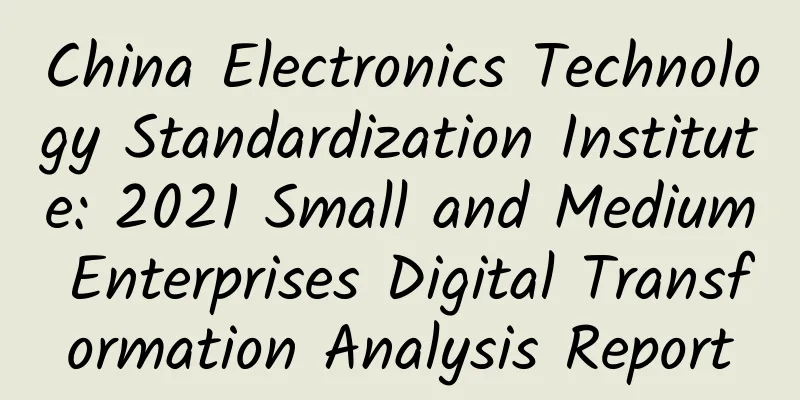China Electronics Technology Standardization Institute: 2021 Small and Medium Enterprises Digital Transformation Analysis Report

|
The China Institute of Electronics Standardization took the lead in formulating the "Guidelines for Digital Transformation of Small and Medium-sized Enterprises" standard. Based on data from more than 15,000 small and medium-sized enterprises, it compiled the "Analysis Report on Digital Transformation of Small and Medium-sized Enterprises (2021)", analyzing the overall situation of digital transformation of small and medium-sized enterprises, and analyzing the progress, results and shortcomings of the transformation from the three perspectives of business transformation, management transformation, and product transformation. On this basis, it puts forward future prospects in order to provide reference for all sectors of society. The "14th Five-Year Plan for Digital Economy Development" clearly proposes to vigorously promote the digital transformation of industries and implement special actions to empower small and medium-sized enterprises with digitalization. In my country, small and medium-sized enterprises are the main force of national economic and social development. At present, the international and domestic economic environment is complex and changeable. Small and medium-sized enterprises are facing problems such as rising factor costs, insufficient innovation and development momentum, and intensified domestic and foreign market competition. The digital transformation of small and medium-sized enterprises is no longer a "multiple choice question", but a "compulsory course" related to survival and long-term development. Under the active guidance of policies, digital transformation is the only way for small and medium-sized enterprises to achieve high-quality development. At the national level, the 14th Five-Year Plan and the Outline of the 2035 Vision Goals clearly propose to accelerate digital development and build a digital China. Among the 14th Five-Year Plans related to the digital transformation of manufacturing released by various central ministries and commissions, 53% of the plans list digital transformation as a major task or key project, providing guarantees for the digital transformation of enterprises in terms of digital infrastructure, key technology research, and digital industry layout. At the local level, in the 14th Five-Year Plan of 31 provinces, autonomous regions, and municipalities, 85% of the competent departments of provinces, autonomous regions, and municipalities have listed the digital transformation of industries as a key task, and 11 provinces, autonomous regions, and municipalities have set up columns to deploy special implementation plans. Since 2022, the work priorities of the governments of 31 provinces, autonomous regions, and municipalities have all included the digital transformation of small and medium-sized enterprises, and they have actively explored new models to help small and medium-sized enterprises transform and upgrade digitally. With the empowerment of universal technology, cleverly leveraging external forces is a quick way to achieve transformation and upgrading. During the 13th Five-Year Plan period, my country's software and information technology service industry developed rapidly, and software business revenue maintained rapid growth, with a compound growth rate of 15.77% in the past three years. The average tariff per unit bandwidth of fixed broadband and per unit traffic of mobile networks dropped by more than 95%, and the average tariff per unit bandwidth of enterprise broadband and dedicated lines dropped by more than 70%. Various fee reduction measures benefited more than 1 billion users annually, with a cumulative profit of more than 700 billion yuan. In 2021, the Ministry of Industry and Information Technology stated that the average bandwidth and dedicated line charges for small and medium-sized enterprises will be reduced by another 10%. At present, the scale of my country's industrial Internet industry has exceeded one trillion yuan, and has been applied in 45 major categories of the national economy, showing a trend of software service platformization, integrated solutions, and industrial service integration. From the overall situation, data shows that in 2021, the proportion of enterprises in the initial exploration stage was 79%, a decrease of 10 percentage points compared with 2020; the proportion of enterprises in the application practice stage was 12%, an increase of 4 percentage points compared with 2020; the proportion of enterprises that reached the deep application stage was 9%, an increase of 6 percentage points compared with 2020. The analysis shows that my country's small and medium-sized enterprises have made positive progress in digital transformation, but the vast majority of enterprises are still in the early stages of digital transformation, and the road to digital transformation is long and arduous. At the same time, more and more enterprises have moved from exploratory practice to in-depth application, and these outstanding enterprises have set a benchmark. From the perspective of enterprise size, data shows that 79% of small and medium-sized enterprises are in the early stages of digital transformation, while more than half of large enterprises have entered the stage of application practice and in-depth application. Analysis shows that large enterprises are rich in funds, talents, and technical resources, and have certain first-mover advantages in digital transformation, while small and medium-sized enterprises are limited by various resources and have a lower overall level of digital transformation. However, small and medium-sized enterprises have the advantages of business focus, flexible mechanisms, and efficient decision-making. In the wave of digital transformation, if they can change their concepts in a timely manner and find the right value incision, they can obtain tangible economic benefits. From the perspective of industry type, the overall level of digital transformation of key industries was statistically analyzed. According to the data from 2021, the average level of digital transformation in industries such as computer, communication and other electronic equipment manufacturing, instrumentation, automobile, furniture, medicine, and electrical machinery ranked at the top. Combined with the data from 2020, automobiles, instrumentation, and electronics are all in the top three, and the level of digital transformation is steadily advancing. However, the level of digitalization in industries such as textiles, chemical fibers, wood processing, and metal smelting is relatively low, and it is necessary to establish industry benchmarks, explore typical scenarios, and drive the overall improvement of the digitalization level of the entire industry. The PDF version will be shared on 199IT Knowledge Planet, just scan the QR code below! |
<<: Are we evolving towards "Iron Man" with smart organ implants?
Recommend
No wonder your phone call volume is so low, it turns out that you forgot to turn on these 3 switches
1. Enable HD calling [[417646]] Click the [Phone]...
Xpeng Motors is going to the sky: the second generation of aircraft is exposed and will be open for test drive in the fourth quarter of next year
As one of the three new car-making forces in Chin...
Metformin's miracle reappears: giving primates' organs a "youthful coat"
Metformin can be said to be a star candidate for ...
You have definitely never seen a “penguin with long legs”!
The Palace Museum published the "Illustrated...
Sleeping for 8 hours does not mean having a good sleep! We have been deceived all along! The truth is...
Many people believe that getting 8 hours of sleep...
This kind of game must be banned! What exactly is this "school death game" that can suffocate people in 3 seconds?
Recently, parents of students in Yiyang, Hunan re...
How to create Douyin store group? Introduction to the operation method of Douyin store group without source of goods
Since Douyin launched e-commerce, many friends ha...
Milk and yogurt are both nutritious, but they may not be what you think...
There are various milk and yogurt products on the...
China Association of Automobile Manufacturers: A brief analysis of the top ten countries to which my country’s automobile exports are exported from January to July 2023
According to data from the General Administration...
Low cost and high activity, how to recall users?
What I will talk about today is mainly related to...
22 satellites in one rocket! Long March 8 opens a new model of shared rocket "carpooling"
On the 27th, the "shared rocket" - the ...
Why is he called the “chief designer” of China’s aerospace industry?
Ren Xinmin, one of the important pioneers of Chin...
Why can’t mobile phones be multi-tasked like computers?
The human brain seems to be naturally equipped wi...
There are so many information flow advertising channels, how do you choose the platform that suits you?
Since 2018, more and more platforms have launched...
After Webb, space will welcome these detection artifacts
For humans, 2021 is coming to an end. But for ast...









